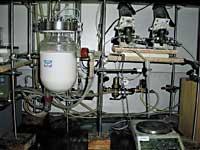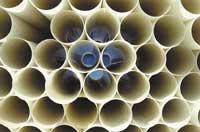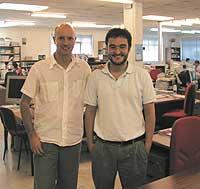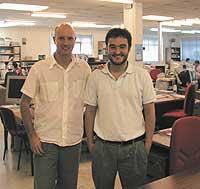Production of ecological paintings
2004/10/01 Ilundain Aranburu, Pedro Iturria: Elhuyar aldizkaria
Due to the health and environmental effects of volatile organic compounds emitted into the atmosphere, a number of measures have been taken internationally to reduce these emissions (Kyoto and Montreal protocols). In addition, since social awareness of the environment, demand for products free of harmful compounds has increased. For example, 70% of the paintings used to paint the facades of the house are cleaned in water.

Emulsion polymerizations have allowed a rapid expansion in the market of products with few volatile organic compounds. In this type of reaction, which is used in the manufacture of paints, among other things, the solvent is replaced by water, obtaining products with a much lower content in harmful compounds.
However, in this type of paint it is essential to have harmful compounds due to the raw material that has remained unreacted and the compounds from other reactions. Therefore, the key is to minimize them. At present, this elimination is carried out in the industry through repeated tests and measurement of the results obtained by each of them, which generates problems.
Harmful to minimum compounds
In this research work, the post-polymerization mechanisms of the most widely used types of paint in the industry, vinyl and acrylic paints have been analyzed in depth. Postpolymerization is a reaction used to remove harmful compounds.
The study allowed selecting the most suitable system to start this reaction. Water-soluble redoxes are best suited for removing raw material that has been left unreacted or the rest of the monomer. In addition, the research has developed a mathematical model to predict the amount of monomer residues to be removed and the generation of new volatile organic compounds.
This model has allowed to optimize post-polymerization until the monomer residue of vinyl and acrylic paints does not exceed 50 parts per million and the amount of volatile organic compounds does not exceed 1,250 parts per million.
Finally, preliminary research has been initiated to reduce volatile organic compounds that are generated in the synthesis of paints. In this way, the problem of harmful compounds is expected from the synthesis itself and reduced by 60%.
In addition, the results obtained in this study have had a direct application in the industry, which has allowed the company Atofina (Serquigny, France) to remarket some vinyl and acrylic paints previously removed by the high level of volatile organic compounds in the countries of the north.
After completing the doctoral thesis, Pedro Ilundain now works at the company Ikerlat Polymers.
- Project title Elimination of the rest of the monomer in latex. Improvement of the post-polymerization process.
- Objective Eliminate latex contaminating compounds used in paints.
- Directors J.M. Asua and M.J. Railing.
- Working group P. Ilundain, R. Salazar, D. Alvarez, L. Da Cunha, M.J. Barandiaran and J.M. Assume.
- Department of Applied Chemistry.
- Faculty of Chemistry.
- Funding Brite-Euram BE 97-4286.

Gai honi buruzko eduki gehiago
Elhuyarrek garatutako teknologia





